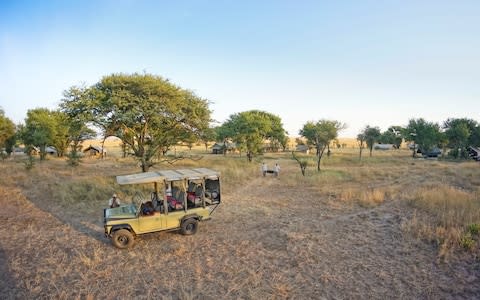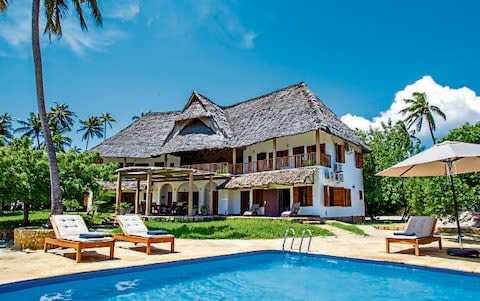My family and 1.5 million other animals: How to make a three-generation safari work

I can tell you the exact moment in my life that I was happiest: I was sitting in a truck with my parents, my husband and my children, and everyone was arguing.
It was my 40th birthday party – a day that began with the great migration and ended with a singing and dancing spectacular.
But first, the debate: with our guide, we were in a truck overlooking the Mara river as between 10,000 and 15,000 wildebeest and their zebra escorts dashed across; there were no other humans for miles around.
In the midst of this mesmeric race, a young wildebeest was snatched by a crocodile. It was the work of an instant, but we all saw it, and were divided: my mother, five-year-old Henry and I saw the pragmatism of the move, and our diplomatic guide, Mussa Gora, pointed out that young crocodiles lurking under the water would share the meal. But my husband, Giles, and my father projected their sense of family on to the hairy adolescent, and mourned its loss. Seven-year-old Antonia joined them, declaring she was becoming a vegetarian, a vow she kept until just before the supper time barbecue.
Family was at the centre of our trip. Many of my friends, upon reaching 40 or 50, throw parties at a Georgian house by the Vauxhall roundabout. These have been great fun. Selfishly, I abandoned my friends and sought a space for our family to do something completely different, together.
Having been on other safaris, I was keen to prioritise animals over sprawling modern hotel complexes; so many safari companies market pools and plush design to families – plus kids’ clubs that outsource the childcare with a few lessons on animal tracks. If that’s what you’re after, I would highly recommend Lewa Wilderness, in northern Kenya.
But the secret to planning a successful three-generation safari is knowing your own family. I wanted to be on the front line of animal action, so we headed to the Serengeti.
Every acre of this bright, wild, open land teems with life. I’ve been on game drives in southern Africa that can go on for hours with few sightings, which won’t work for anyone in possession of a short attention span; here, on the dramatic Lamai Wedge in the northern tip of Tanzania’s most famous national park, the animals are many, but other guests are relatively few.
Asilia’s semi-mobile Kimondo camp tracks the seasonal 1,200-mile trek of 1.5 million wildebeest from just north of the Mara, near the Kenyan border, culminating in the migration in late October. It then moves down to the lush southern Serengeti grasslands for calving from January to March.

Composed of nine wood and canvas tents, Kimondo is entirely open to the plains. When you have an evening cocktail around a campfire, or spend the midday, as my children and I did, painting the landscape from under the shade of a tree, you’ll gaze out on thousands of animals. Its old-fashioned tents have king-size iron beds, but also (pleasantly heated) bucket showers discreetly open to the surrounding hordes of beasts; you can, as my children discovered to their joy, wash while serenading passing wildebeest in an area so vast it feels like an ocean.
As lively as this scene was, death was a prominent feature of our celebration. On our first drive out, Mussa told me quietly that he’d seen a group of wildebeest in a closed circle that morning. He’d investigated and found that they were shielding a dying young member of their group. Would we like to see it? Did I think the children could stomach death?
Seeing real life was exactly why we’d come, so we zoomed off to watch the writhing beast. It had the turning disease, Mussa said, causing it to lose coordination and gallop in circles. This animal was on its last legs.
Antonia insisted, at the start and end of each subsequent day, that we stop by the site, where we encountered first lions, then hyenas, and finally a conference of 30 vultures with a marabou stork lingering in the background. It was the perfect illustration of the efficiency of the food chain, from meat to skeleton to nothing at all. In our first few hours at Kimondo we saw four of the Big Five, but it was the lesson in death that would stick most with the children.

My parents, who are in their 60s, went with interest and some trepidation on their first trip to Africa. Any worry dissolved on the first night, a layover in Arusha that no one had particularly looked forward to – we wanted to get to where the action was. While the children and I went for a swim in the shady pool at River Trees, a pretty colonial-style complex of cottages near the airport, my father made his first friends; we found him 30 minutes later happily chatting to the waiters under the shade of the trees by the outdoor pizza oven. This trend continued: at Kimondo, Dad conspired with Richard, the camp manager, to throw a birthday party for me on our last night, at which all 30 staff donned costumes and danced and sang, while the chef produced a delicious chocolate birthday cake from the camp’s kitchen.
For the final leg of our journey, we took a tiny plane to the north-eastern point of Tanzania to stay on Ushongo Beach. It’s a 25-minute flight from Zanzibar but is seldom visited by international tourists. We’d been lured by a large villa attached to a small beach-hut hotel, which promised conservation education and exploration of an area in development.
What we found was a funny study in contrasts: the high spec of the timber, stone and thatch cottage, decked out with South African game photographs and furniture, and the beauty of the surrounding gardens and saltwater swimming pool, make for a relaxing stay. But the local infrastructure is basic and the volume of plastic rubbish on the beach dispiriting.

The night we arrived, the exceptionally friendly local staff, headed by Mwindadi Omari, their talented manager, had prepared a feast of the rich spiced coconut milk and tomato curries beloved of the Swahili Coast. As we sat over a leisurely meal on the veranda overlooking the Indian Ocean, more than a dozen uniformed adults trooped in, clapping, stomping and singing. The assistant manager of The Tides, the sister hotel down the coast, had sent his church’s choir to welcome us. As Dad wryly observed next morning, it would take a great many more years of piano and singing lessons to give us anything close to their sense of rhythm and harmony.
On the coast, I watched my children, who are on the cusp of confident swimming, play monkey in the middle in the pool for hours, attracting mild sunburn but little interest from the actual vervet monkeys in the garden.
We had a few bumps at Mawimbi House. It rained for a few days, which was unavoidable. We had intended to visit Saadani, Tanzania’s only seaside national park (search online: you’ll see lions walking in pairs on the beach like honeymooners), but the roads are so poor that the weather made the trip impossible.
We tried an excursion in a fisherman’s boat to Maziwe, a small marine reserve where we were to snorkel in the coral and learn about turtle conservation. Alas, the weather scuppered this too, and – gamely cracking jokes to keep the children’s spirits up as our small vessel swung alarmingly upwards over giant waves – Mwindadi ordered us back to shore and deftly swapped the day’s itinerary, replacing conservation with culture.

Born in the local fishing village, Mwindadi knows everyone along the coast, and he invited a local artist to come and teach the children his painting style. He also got an expert tree-climber from his village to visit; the man climbed a palm in less than a minute, using only coconut fronds for support. Like the choir, these events were cultural sharing that was informative, interesting, and presented on friendly, equal ground; it had none of the awkward voyeurism of, for example, Masai village visits I’ve undertaken in the past.
The warmth is there for perfect hospitality in this corner of the Pangani and Tanga region. But it needs better infrastructure and more coordinated management, from the government or the hotels, to prepare it for more responsible tourism. The beach, yards from our villa, was dotted with plastic rubbish – it washes ashore particularly in storms, I was told. But even the hotel’s publicity photos, upon close inspection, show plastic bottles on the beach, and it made the sand an unpleasant place to sit.
To make this spot shine, the beaches and roadsides need regular cleaning, like the hotels on the neighbouring islands of Zanzibar and Pemba do. And we all need to help reduce the plastic waste that spoils this stunning habitat.
Asilia, the safari company, is a leader in conservation. Most of the energy used by its mobile camps is solar; when we arrived we were each handed reusable metal water bottles which we are all still using six months later. Asilia invests in local people as much as in the environment: its staff training programmes are highly respected and it has a camp entirely run by women – this is an excellent example of what the future of East African tourism should look like.
It’s impossible to guarantee outcomes, particularly with family. But as I look back over pictures of my mother gaping with my son at the sheer volume of animals rushing across the Mara; of my father and my daughter concocting ever-more-elaborate angles for catch in the pool; of my father and husband enjoying a beer together overlooking the sunset over the Mara River, I cannot help but smile. These were perfect moments of being, revelations of the essence of what we want in family travel – time to explore, together. What a way to welcome the next decade.
How to book
A seven-night trip with one night at River Trees, three at Kimondo and three at Mawimbi House costs from £3,505 per adult and £3,132 per child, sharing. Africa Travel Resource (africatravel-resource.com). Includes meals, regular drinks at Asilia’s Kimondo Camp and The Tides’ Mawimbi Villa, and internal flights. Fly to Arusha with Ethiopian Airlines for October half term from £490.

